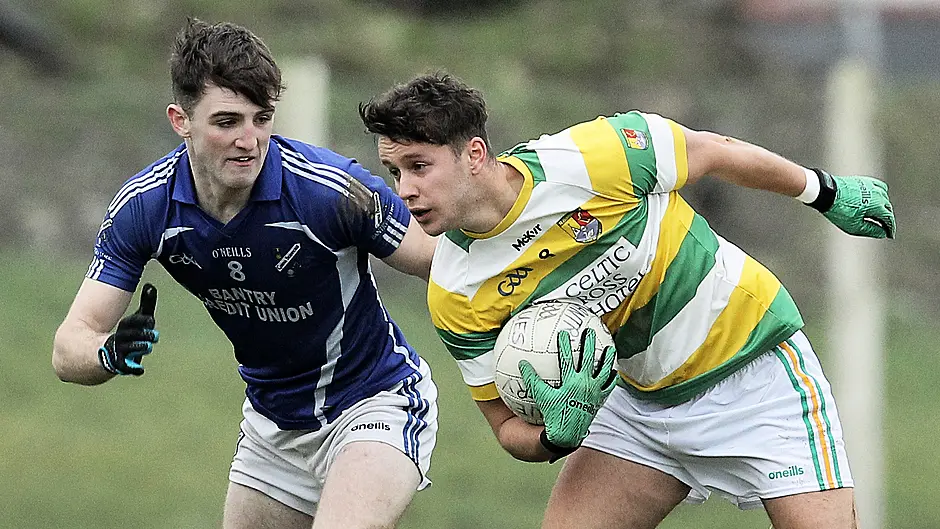TOM LYONS shares his first impressions of the new football rules in action at club level
LAST weekend provided our first real view of the new football rules in action when the first round games in the Carbery U21 football championships were played off.
We had seen the rules in operation at inter-county level on television and reserved judgement as to how they would fit it at club level. Seeing the whole pitch and how players position themselves is vital to understanding the effects of the new rules.
So, item one, the pitch itself and the new markings, especially the 40-metre arc. Our game at the weekend was in Drimoleague, between Bantry Blues and Carbery Rangers in the U21A grade, and even though the grass was, understandably, heavy to protect the pitch at this time of the year, the lines were clearly marked.
We spoke to local Brian Deane who admitted that marking the arc was not easy for the first time and that part of it might be a bit flat instead of an arc. It was still well done but our problem was that, standing on the sideline, it wasn’t easy to see the arc at the far side but it was plainly visible from the hill for supporters.
The first new rule to come into play was the solo-and-go free, where a player is fouled, the referee blows the whistle but the player continues playing. This is definitely a huge plus in speeding up the game, non-stop play, whereas in the past defenders could foul an attacker, the play would stop and the defenders would have time to get back into place. Now, with play continuing, players are often at a disadvantage when fouling, which is only right. A big thumbs up for this new rule.
We had to wait over 20 minutes for the first two-pointer, from a free, and it definitely had a big influence on the trend of the game. The first from play came a few minutes later. There is no doubt that a team containing players who can kick two-pointers will have a big advantage over teams that don’t. I have two reservations about the two-pointer rule, first that a team well on top in a game and capable of kicking two pointers, could open up a big gap, leading to some very one-sided games. Second, we witnessed a number of players trying to kick two-pointers, with the ball falling short into the goalkeeper’s hands.
As regards goalkeepers, we didn’t see either keeper venturing out the field, creating the extra attacker that has become a problem at inter-county level. I would imagine we will see an adjustment to the goalie’s role to limit this influence he has on the game.
Only once did we see a team being penalised over not keeping three players back, but it definitely opened up the forward section of the pitch, providing much more scope for good forwards to operate. This rule does favour good, fast forwards and will be enjoyed by spectators but how many kids will put up their hands in training offering to be one of the three chosen rearguard defenders? Over time, it will become more fluid in the top grades but may result in a shortage of defenders at underage level. It does work in opening up space and is a worthwhile change. It was good to see the linesmen on their toes as regards enforcing this rule and informing the referee.
We also witnessed only one instance of a free being taken forward 50 metres for dissent and while we thought, when the rules were introduced, that this was severe, we didn’t have one single incident of referee abuse from the sideline, which is to be welcomed. The players were also on their best behaviour as regards discipline towards the referee, which, hopefully, will lead to an influx of new young referees later on.
Full marks to the referee on the day who applied the rules very well. We were worried about how the referee would signal to his umpires that a score was a two pointer but it was clearly signalled by hand on both occasions and we had our first sighting of the new orange flag (or is it really red?).
Having the goalkeeper sending the kickouts beyond the 40-metre arc meant we saw some fine high fielding around the middle of the pitch, with only one transgression. Good fielders will again become a necessity on teams around the middle third and that is to be welcomed. Strangely, we didn’t see a single forward mark inside the 20-metre line during the game, the player having the option to play on and returning to the mark if he misses the score.
At the start of the game, we wondered why one of the midfielders was standing on the sideline near us until we remembered that only one player is allowed from each side for the throw-in, the other standing on the sideline. While acknowledging that we often see a bit of mayhem among the players waiting for the throw-in with an instant foul often occurring, we still have to be convinced that this change was necessary.
Overall, we were happy with the implementation of the new rules in general, with a little tweaking still to be done. They have definitely speeded up the game, are going to bring back the art of good kicking in the forward line and do open up space. The rules reward good fielders and fast forwards and that should increase the enjoyment for spectators. Football had become unwatchable for many people, especially older ex-players, in recent years, and the rules will go a long way to rectifying that problem.








